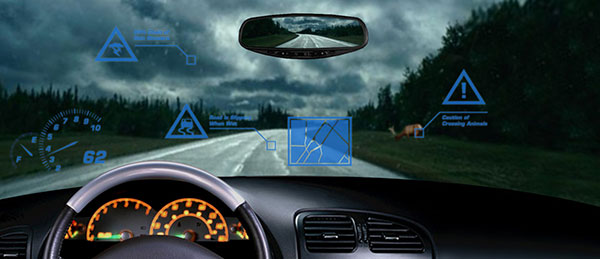Just imagine using your entire car windshield as a fully transparent display with many additional information details showing up on a wide Head-Up display automatically. These Head-Up Displays are no science fiction anymore. In fact there are development kits available which help you to build up full windshield Head-Up Display (fw-HUD) applications on your car windshield.

Increased Awareness
A heads-up display (HUD) or head-up display provides users with a wide array of data on a transparent display in front of their eyes. This setup allows the user to avoid looking away from the usual lines of sight. Initially developed for aviation, the name “HUD” derives from a pilot’s ability to view data with the head in an “up” position, looking forward, rather than downward at the actual instruments. This technology, coupled with the increasing amount of information available on a HUD, has enabled a wide variety of military and some commercial aircraft to fly more securely in poor weather or at night.
Commercially Available
In 1988, General Motors put a HUD system into a handful of cars. These systems projected the instrument display onto the windshield of a Cutlass Supreme Pace Car and fifty replicas. In 1991, Toyota introduced the Crown Majesta, its flagship domestic model, with a HUD system. Gradually, HUD systems began to improve. The Corvette featured the first color HUD in 1998. In 2003, BMW offered a system in its 2004 5 Series that displayed in multiple colors, with brightness adjusted to ambient light, and customizable with navigation information (which, at the time, came on a DVD-based system).
Today, similar systems are increasingly available on many luxury car models, and some non-luxury models. Heads-up display is even standard on the Toyota Prius. Speed, hybrid system information, and navigation data are available on the HUD, which also allows the driver to adjust brightness and position of the projected image.
Alternatives
For vehicle models where a HUD is not available, consumers have the option of purchasing an add-on HUD system. These systems project their display onto a combiner – a flat piece of coated glass that redirects the projected image. You can also achieve a similar display through the use of smartphones like the iPhone or Android, which have internal GPS. Simply download a HUD app and mount your smartphone to project your speed and navigation data into your driver’s line of sight.
These add-on or smartphone HUDs are much cheaper and can be installed on practically any vehicle. They have limitations though – without a combiner, the phone-generated displays project directly onto the windshield and work well only in the dark. Furthermore, too much information broadcast into your line of sight may potentially distract from your main task – driving.
Increased Safety
Even so, car companies are experimenting with newer technologies that are not just impressive, but also enhance driver safety. For example, GM is experimenting with “augmented reality” HUD displays that show information about road hazards ahead or cars in your blind spot. Such an enhanced system would gather road information through sensors and then “overlay” on the windshield an enhanced outline of the road, for example, in foggy or nighttime conditions. The windshield overlay has been shown to improve driver performance.
Audi is another innovator, developing HUD features that allow vehicle passengers to have a separate screen to access digital travel information and news while on the road. It would also allow the passenger to determine a travel route using the system and manually swipe it over to a driver’s HUD screen through hand gestures.
Finally, with Google planning to launch personal HUD glasses by the end of 2012, up-to-date digital information about your surroundings from weather to nearby businesses may soon follow you in or out of your vehicle. Developments involving glasses, as well as add-on features, also have the advantage of being able to incorporate newer technology even as your car gets older.
Suggested reading:
- Google’s first Project Glass sees the Light
- Smart Glasses: Future Technology
- 5 Technological Advancements to look forward in 2013
This article was written by Brigitte Jenkins on behalf of Mark Blair of Bay Area DUI Law. Increased technology and safety in cars can prevent many more accidents from taking place, but misjudgments can still happen.
